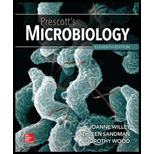
Prescott's Microbiology
11th Edition
ISBN: 9781260409062
Author: WILLEY, Joanne
Publisher: MCGRAW-HILL HIGHER EDUCATION
expand_more
expand_more
format_list_bulleted
Concept explainers
Textbook Question
Chapter 20.3, Problem 1CC
Retrieve, Infer, Apply
Why are the growth yields of most methanogens much lower than those of microbes that grow aerobically?
Expert Solution & Answer
Want to see the full answer?
Check out a sample textbook solution
Students have asked these similar questions
Give typed full explanation
Consider the following equation: Nt = N0ert 1. What type of growth is modelled by this equation?
Discuss, how is it possible to isolate both aerobes and anaerobes using streak plates?
Citrate test
What critical enzyme allows the organism to acquire carbon from the medium?
Chapter 20 Solutions
Prescott's Microbiology
Ch. 20.1 - MICRO INQUIRY Given that the DC/HB pathway uses...Ch. 20.1 - Prob. 2MICh. 20.1 - Prob. 1CCCh. 20.1 - Why do methanogens use the reductive acetyl-CoA...Ch. 20.1 - Prob. 3CCCh. 20.1 - Compare the ATP and NADH yield of each of the...Ch. 20.2 - MICRO INQUIRY Identify the potential electron...Ch. 20.2 - Retrieve, Infer, Apply What are thermoacidophiles...Ch. 20.2 - Prob. 2CCCh. 20.2 - Compare the carbon and sulfur metabolism of...
Ch. 20.2 - Prob. 4CCCh. 20.2 - Prob. 5CCCh. 20.3 - MICRO INQUIRY What are the mechanisms by which...Ch. 20.3 - Retrieve, Infer, Apply Why are the growth yields...Ch. 20.3 - Prob. 2CCCh. 20.3 - What is the ecological and practical importance of...Ch. 20.3 - Where are extreme halophiles found, and what is...Ch. 20.3 - What is the difference between sensory rhodopsin...Ch. 20.3 - How is Thermoplasma able to live in acidic, very...Ch. 20.3 - In what way are members of the genus Archaeoglobus...Ch. 20 - Prob. 1RCCh. 20 - Prob. 2RCCh. 20 - Prob. 3RCCh. 20 - Prob. 4RCCh. 20 - Prob. 5RCCh. 20 - Prob. 6RCCh. 20 - Prob. 7RCCh. 20 - Some believe that archaea should not be separate...Ch. 20 - Prob. 2ALCh. 20 - Prob. 3ALCh. 20 - Prob. 4ALCh. 20 - Prob. 5ALCh. 20 - Prob. 6ALCh. 20 - Prob. 7AL
Knowledge Booster
Learn more about
Need a deep-dive on the concept behind this application? Look no further. Learn more about this topic, biology and related others by exploring similar questions and additional content below.Similar questions
- Give 2 fluorogenic methods that can be used in detecting coliforms and E.coli.arrow_forwardIn this exercise, what will be the outcome if B. megaterium was grown in a rich medium? Explain.arrow_forwardDiscuss the benefit and drawbacks of using cell suspension culture for the production of important secondary metabolites.arrow_forward
- Explain the advantages of fed-batch operation mode and give an example for a type of product obtained by fed-batch bioprocess.arrow_forwardxplain the four stages of the growth curve for a microorganism. What is the generation time? Which aspect of the growth curve is used to calculate the generation time and why? How is the generation time calculated and why does it make sense that E.coli and M.tuberculosis have such drastically different generation times?arrow_forwardInoculate 250-µL overnight cell culture into 50 ml LB medium (in a 250 ml flask). Shake vigorously at 37 °C to OD600~0.5-0.6 (usually it takes about 2-3 hours). Why should we use a larger flask during culture at this step? Why do we need to wait till this OD range is achieved?arrow_forward
- Hypothetically make the Dichotomous key for Micrococcus luteus, Bacillus subtilis, Bacillus, Megaterium, Bacillus cereus, E.coli, Serratia Marcescens, and Enterobacter aerogenes based on colony morphology. results of catalase test, (lactose, sucrose and glucose fermentation tests) and other biochemical tests for its accurate identification.arrow_forwardBriefly discuss the problem of heat management in electrophoretic separations of biomacromolecules.arrow_forwardBriefly explain that what is the important to use immobilization techniques in biosensor?..(explain under5 points)arrow_forward
arrow_back_ios
SEE MORE QUESTIONS
arrow_forward_ios
Recommended textbooks for you
 Human Anatomy & Physiology (11th Edition)BiologyISBN:9780134580999Author:Elaine N. Marieb, Katja N. HoehnPublisher:PEARSON
Human Anatomy & Physiology (11th Edition)BiologyISBN:9780134580999Author:Elaine N. Marieb, Katja N. HoehnPublisher:PEARSON Biology 2eBiologyISBN:9781947172517Author:Matthew Douglas, Jung Choi, Mary Ann ClarkPublisher:OpenStax
Biology 2eBiologyISBN:9781947172517Author:Matthew Douglas, Jung Choi, Mary Ann ClarkPublisher:OpenStax Anatomy & PhysiologyBiologyISBN:9781259398629Author:McKinley, Michael P., O'loughlin, Valerie Dean, Bidle, Theresa StouterPublisher:Mcgraw Hill Education,
Anatomy & PhysiologyBiologyISBN:9781259398629Author:McKinley, Michael P., O'loughlin, Valerie Dean, Bidle, Theresa StouterPublisher:Mcgraw Hill Education, Molecular Biology of the Cell (Sixth Edition)BiologyISBN:9780815344322Author:Bruce Alberts, Alexander D. Johnson, Julian Lewis, David Morgan, Martin Raff, Keith Roberts, Peter WalterPublisher:W. W. Norton & Company
Molecular Biology of the Cell (Sixth Edition)BiologyISBN:9780815344322Author:Bruce Alberts, Alexander D. Johnson, Julian Lewis, David Morgan, Martin Raff, Keith Roberts, Peter WalterPublisher:W. W. Norton & Company Laboratory Manual For Human Anatomy & PhysiologyBiologyISBN:9781260159363Author:Martin, Terry R., Prentice-craver, CynthiaPublisher:McGraw-Hill Publishing Co.
Laboratory Manual For Human Anatomy & PhysiologyBiologyISBN:9781260159363Author:Martin, Terry R., Prentice-craver, CynthiaPublisher:McGraw-Hill Publishing Co. Inquiry Into Life (16th Edition)BiologyISBN:9781260231700Author:Sylvia S. Mader, Michael WindelspechtPublisher:McGraw Hill Education
Inquiry Into Life (16th Edition)BiologyISBN:9781260231700Author:Sylvia S. Mader, Michael WindelspechtPublisher:McGraw Hill Education

Human Anatomy & Physiology (11th Edition)
Biology
ISBN:9780134580999
Author:Elaine N. Marieb, Katja N. Hoehn
Publisher:PEARSON

Biology 2e
Biology
ISBN:9781947172517
Author:Matthew Douglas, Jung Choi, Mary Ann Clark
Publisher:OpenStax

Anatomy & Physiology
Biology
ISBN:9781259398629
Author:McKinley, Michael P., O'loughlin, Valerie Dean, Bidle, Theresa Stouter
Publisher:Mcgraw Hill Education,

Molecular Biology of the Cell (Sixth Edition)
Biology
ISBN:9780815344322
Author:Bruce Alberts, Alexander D. Johnson, Julian Lewis, David Morgan, Martin Raff, Keith Roberts, Peter Walter
Publisher:W. W. Norton & Company

Laboratory Manual For Human Anatomy & Physiology
Biology
ISBN:9781260159363
Author:Martin, Terry R., Prentice-craver, Cynthia
Publisher:McGraw-Hill Publishing Co.

Inquiry Into Life (16th Edition)
Biology
ISBN:9781260231700
Author:Sylvia S. Mader, Michael Windelspecht
Publisher:McGraw Hill Education
Microbial Nutrition and Growth; Author: Scientist Cindy;https://www.youtube.com/watch?v=rK3UkyWjkl8;License: Standard YouTube License, CC-BY